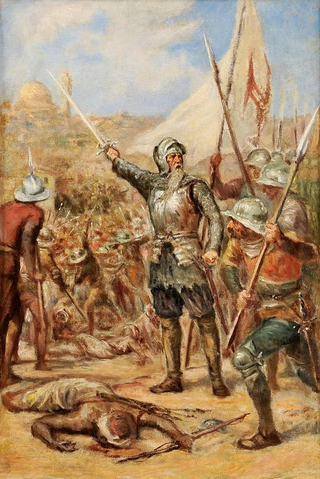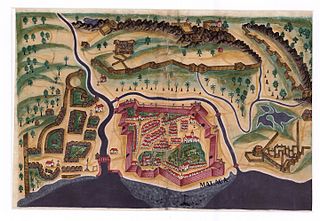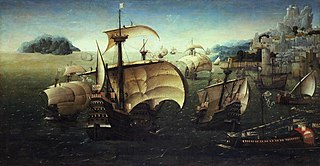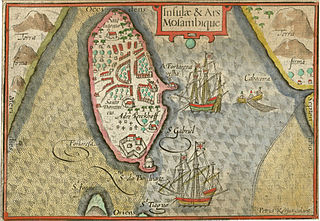Sultan Alauddin Riayat Shah II ibni Almarhum Sultan Mahmud Shah was the first sultan of Johor. He ruled Johor from 1528 to 1564. He founded the Johor Sultanate following the fall of Malacca to the Portuguese in 1511. He was the second son of Mahmud Shah of Malacca. Thus, Johor was a successor state of Malacca and Johor's sultans follow the numbering system of Malacca. Throughout his reign, he faced constant threats from the Portuguese as well as the emerging Aceh Sultanate.

The Battle of Cape Rachado, off the present-day Malaccan exclave of Cape Rachado in 1606, was an important naval engagement between the Dutch East India Company and Portuguese fleets.

Portuguese control of Malacca, a city on the Malay Peninsula, spanned the 130 year period (1511–1641) when it was a possession of the Portuguese East Indies. It was conquered from the Malacca Sultanate as part of Portuguese attempts to gain control of trade in the region. Although multiple attempts to conquer it were repulsed, the city was eventually lost to an alliance of Dutch and regional forces, thus entering a period of Dutch rule.

The Ottoman-Portuguese conflicts were a period of conflict during the Ottoman–Portuguese confrontations and series of armed military encounters between the Portuguese Empire and the Ottoman Empire along with regional allies in and along the Indian Ocean, Persian Gulf, and Red Sea.

The Capture of Malacca in 1511 occurred when the governor of Portuguese India Afonso de Albuquerque conquered the city of Malacca in 1511.

The Battle of Duyon River was a naval engagement between the Portuguese forces commanded by Nuno Álvares Botelho, who is renowned in Portugal as one of the last great commanders of Portuguese India, and the forces of the Sultanate of Aceh, which were led by Lassemane.

The War of the League of the Indies was a military conflict in which a pan-Asian alliance formed primarily by the Sultanate of Bijapur, the Sultanate of Ahmadnagar, the Kingdom of Calicut, and the Sultanate of Aceh, referred to by the Portuguese historian António Pinto Pereira as the "league of kings of India", "the confederated kings", or simply "the league", attempted to decisively overturn Portuguese presence in the Indian Ocean through a combined assault on some of the main possessions of the Portuguese State of India: Malacca, Chaul, Chale fort, and the capital of the maritime empire in Asia, Goa.
The siege of Johor of 1587 was a military operation in which Portuguese forces successfully sieged, sacked, and razed Johor, capital of its eponymous Sultanate. The city would later be rebuilt in a different location.

The Battle of Pungo Andongo, also known as the siege of Pungo Andongo was a military engagement in what is today Angola between Portugal and the Kingdom of Ndongo whose capital, Pungo Andongo, also known as Pedras Negras, was besieged. After a nine-month encirclement, the capital was taken by storm, plundered and occupied by the Portuguese.

The Battle of El Tor was a military engagement that took place in 1541, between Portuguese forces under the command of the Governor of India Dom Estevão da Gama and those of the Ottoman Empire then in the city of El Tor, on the Sinai Peninsula. The Turks were driven from the city, but at the request of Christian monks from the Monastery of Saint Catherine the Portuguese spared the city from being plundered, and celebrated a mass and a knighting ceremony therein.
The siege of Bintan of 1526 was a military operation in which Portuguese forces successfully sieged, assaulted and destroyed the city of Bintan, capital of the former sultan of Malacca Mahmud Shah.
The Battle of Pago was a military operation that took place in 1520, and in which Portuguese forces successfully attacked Pago, where the former Sultan of Malacca Mahmud Shah had built a fortified camp to harass Portuguese Malacca.
The Battle of Ugentana, also known as Battle of Ugentana River was a military operation that took place in 1535, between Portuguese forces and those of sultan Alauddin Riayat Shah II of Johor.

The Battle of Perlis River was an armed engagement that took place in 1547 within Perlis River, Malaysia, between a Portuguese fleet and a fleet of the Sultanate of Aceh. The Portuguese achieved "a complete victory" over the Acehnese fleet, which was almost completely destroyed.
The Battle of Formoso River of 1615 was an naval battle that took place in the Malay peninsula within Formoso River, between a Portuguese fleet and a large fleet of the Sultanate of Aceh, one of the largest Aceh had ever mobilized against the Portuguese in Malacca.

Malay-Portuguese conflicts refer to the military engagements between the forces of the Portuguese Empire and the various Malay states and dynasties, fought intermittently from 1509 to 1641 in the Malay Peninsula and Strait of Malacca.

Acehnese–Portuguese conflicts were the military engagements between the forces of the Portuguese Empire, established at Malacca in the Malay Peninsula, and the Sultanate of Aceh, fought intermittently from 1519 to 1639 in Sumatra, the Malay Peninsula or the Strait of Malacca. The Portuguese supported, or were supported, by various Malay or Sumatran states who opposed Acehnese expansionism, while the Acehnese received support from the Ottoman Empire and the Dutch East India Company.

The siege of Malacca of 1551 was a military engagement that took place in the Malay Peninsula, between the Portuguese Empire and the allied forces of the Sultanate of Johor, the Sultanate of Pahang, the Sultanate of Perak and the Sultanate of Jepara in Java. The Portuguese were victorious.

Gujarati–Portuguese conflicts refers to the armed engagements between the Portuguese Empire and the Sultanate of Gujarat, in India, that took place from 1508 until Gujarat was annexed by the Mughal Empire in 1573.

The siege of Mozambique of 1608 was a second, unsuccessful, attack by the Dutch East India Company on the Portuguese fortress of Mozambique, on the island of Mozambique, in 1608.











